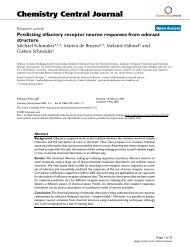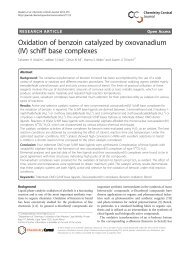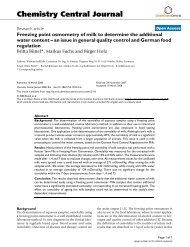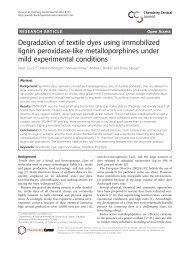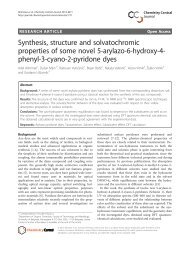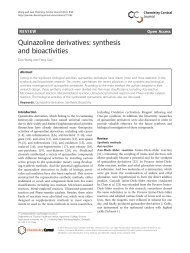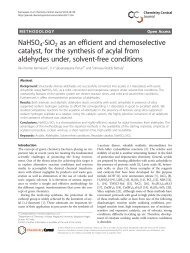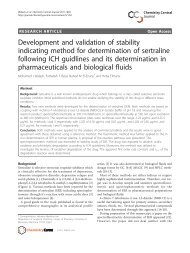PDF - Chemistry Central Journal
PDF - Chemistry Central Journal
PDF - Chemistry Central Journal
- No tags were found...
You also want an ePaper? Increase the reach of your titles
YUMPU automatically turns print PDFs into web optimized ePapers that Google loves.
Wu et al. <strong>Chemistry</strong> <strong>Central</strong> <strong>Journal</strong> 2012, 6:51http://journal.chemistrycentral.com/content/6/1/51RESEARCH ARTICLEOpen AccessSynthesis and antifungal activity of novelpyrazolecarboxamide derivatives containing ahydrazone moietyJian Wu 1,2† , Jian Wang 1,2† , Deyu Hu 1,2 , Ming He 1,2 , Linhong Jin 1,2 and Baoan Song 1,2*AbstractBackground: The plant pathogenic fungus (such as Gibberella zeae, Fusarium oxysporum and Cytosporamandshurica) causes devastating disease in agriculture. The pathogenic fungus is responsible for billions of dollarsin economic losses worldwide each year. In order to discover new fungicidal molecule with good fungicidal activityagainst G. zeae, F. oxysporum, and C. mandshurica, we sought to combine the active sub-structure of hydrazone andpyrazole amide derivatives together to design and synthesize novel pyrazole amide derivatives containing ahydrazone moiety.Results: A series of novel pyrazole amide derivatives bearing hydrazone moiety were synthesized. Their structureswere characterized by 1 H-NMR, 13 C-NMR, IR, and elemental analysis. The preliminary biological assays revealed thatmost of the synthesized compounds exhibit favorable antifungal activities against G. zeae. The activity ofcompounds 7a, 7f, 7g, 7h, 7i, 7j, 7l and 7q were 40.82%, 47.78%, 50.32%, 40.82%, 49.05%, 48.73%, 40.19% and45.89%, respectively, and the synthesized compounds showed certain antifungal activities against F. oxysporum andC.mandshurica.Conclusion: A practical synthetic route to pyrazole amide derivatives containing a hydrazone moiety were synthesizedby the condensation of intermediates 5-chloro-N-(4-subsititued-2-(hydrazinecarbonyl)-6-methylphenyl)-1,3-dimethyl-1 H-pyrazole-4-carboxamide with different aldehydes or ketones in ethanol at room temperature is presented, the results ofthe study suggested that the pyrazole amide derivatives containing hydrazone moieties could inhibit the growth of G.zeae, F. oxysporium and C. mandshurica to a certain extent.BackgroundThe phytopathogenic fungus such as Gibberella zeae,which is also known as anamorph Fusarium graminearum,poses serious threats to agriculture. It is a broadhost range pathogen that infects many crop plants, includingwheat and barley, and causes head blight and rotdiseases throughout the world [1]. The high incidence ofplant mortality and the lack of effective control methodsmake the pathogen are responsible for billions of dollarsin economic losses worldwide each year [2]. In recentyears, because of continued moist weather during the* Correspondence: basong@gzu.edu.cn† Equal contributors1 State Key Laboratory Breeding Base of Green Pesticide and AgriculturalBioengineering, Key Laboratory of Green Pesticide and AgriculturalBioengineering, Ministry of Education, Guizhou University, Guiyang, China2 Research and Development Center for Fine Chemicals, Guizhou University,Guiyang 550025, Chinacrop growing season and the failure of chemical controlin some areas due to fungicides resistance in the pathogenpopulation, Fusarium head blight (FHB) have beenendemic in the wheat-producing areas of many provinceof China, which have caused an estimated 30 to 50% ofreduction and even completely failure of harvests inmany wheat-producing areas. Therefore, the design ofnew compounds to deal with G. zeae has become one ofthe most important areas for fungicide research today.Pyrazole amide derivatives play an important role in developmentof medicine and pesticide due to their broadspectrum of biological activity [3-8]. Considerable attentionfor the study of synthesis and biological activity of pyrazoleamide derivatives has been paid in recent years [9]. Currently,some pyrazole amide derivatives have been developedand commercialized as pesticide. As shown inFigure 1, furametpyr, penthiopyrad, tolfenpyrad, and© 2012 Wu et al.; licensee <strong>Chemistry</strong> <strong>Central</strong> Ltd. This is an Open Access article distributed under the terms of the CreativeCommons Attribution License (http://creativecommons.org/licenses/by/2.0), which permits unrestricted use, distribution, andreproduction in any medium, provided the original work is properly cited.
Wu et al. <strong>Chemistry</strong> <strong>Central</strong> <strong>Journal</strong> 2012, 6:51 Page 2 of 5http://journal.chemistrycentral.com/content/6/1/51H 3 CH 3 CONHOCH 3CH 3F 3 CNNONHClSCH 3NNH 3 CClFurametpyrH 3 CH 3 CPenthiopyradCH 3BrH 3 CH 2 CN NClHNOCH 3HNOHNONNNClH 3 COTolfenpyradClChlorantraniliproleOOCNHNbenquinoxNOHNHNN NFerimzoneNOHON NH NHDiflufenzopyrFFFigure 1 The commercialised pesticide of pyrazole amide and hydrazone derivatives.chlorantraniliprole are known for their ability to protectcertain plants from severe diseases and pests. In the pastfew years, hydrazone derivatives has been also attractedmore and more attention due to their particular physical,chemical, and biological activities[10].Hydrazone,aclassof important substructure, can be found in numerouspharmaceutically active compounds [10,11], and have beendemonstrated to bear important biological activities (suchas antibacterial activity [12,13], analgesic activity [14], antinociceptiveactivity [15], insecticidal activity [16,17], antimalarialactivity [18], and antimicrobial activity [19,20]).Some of the compounds containing hydrazone substructurehave been commercialized as pesticides (such as benquinox,diflufenzopyr, and ferimzone) (Figure 1). In ourrecent publications [21,22], several hydrazone derivativeshave been synthesized and tested for their insecticidal activityand antibacterial activity, some of the hydrazone derivativesexhibited notable insecticidal activity against Plutellaxylostella, Helicoverpa armigera, Culex pipiens pallens,Laphygma exigua, Spodoptera litura, Nilaparvata lugensand Rhopalosiphum maidis [21], and some of the hydrazonederivatives containing a pyridine moiety possessedgood antibacterial activity against Ralstonia Solanacearum[22].Keeping this in view, in an effort to discover new moleculesagainst G. zeae, F. oxysporum and C. mandshurica,we sought to combine the sub-structural units of pyrazoleamide and hydrazone together to design and synthesizenovel pyrazole amide derivatives containing a hydrazonesubstructure. Thus, 11 novel pyrazolecarboxamide derivativeswere synthesized using 3-dimethyl-1 H-pyrazol-5(4 H)-one and 2-amino-5-chloro-3-methylbenzoic acid asstarting materials. All synthesized compounds wereunequivocally characterized by IR, NMR and elementalanalysis. The fungicidal activity on G. zeae, F. oxysporiumand C. mandshurica were evaluated, the results showedthat most of the synthesized compounds exhibit favorableantifungal activity against G. zeae and a certain antifungalactivity against F. oxysporum and C. mandshurica,ofwhich,compounds 7g and 7i display good activities at 50 mg/L.To the best of our knowledge, this is the first report on theantifungal activity of hydrazone derivatives containing apyrazole moiety.Results and discussionSynthesisThe synthetic route to the title compounds is outlined inScheme 1 [see Additional file 1]. Intermediates 4 were preparedusing 1,3-dimethyl-1 H-pyrazol-5(4 H)-one as startingmaterials. 1,3-dimethyl-1 H-pyrazol-5(4 H)-one wasfirstly subjected to Vilsmeier-Haack chloroformylationusing N,N-dimethylformamide (DMF) and phosphorus
Wu et al. <strong>Chemistry</strong> <strong>Central</strong> <strong>Journal</strong> 2012, 6:51 Page 3 of 5http://journal.chemistrycentral.com/content/6/1/51oxychloride (POCl 3 ) to yield 5-chloro-1,3-dimethyl-1 H-pyrazole-4-carbaldehyde 1[9], which was further oxidizedby potassium permanganate and following chlorinatedwith thionyl chloride (SOCl 2 ) to provide the intermediates3, then intermediates 4 were prepared by treating 5-chloro-1,3-dimethyl-1 H-pyrazole-4-carbonyl chloride with2-amino-3-methylbenzoic acid or 5-chloro-2-amino-3-methylbenzoic acid in CH 2 Cl 2 in present of triethylaminein good yields, 2-(5-chloro-1,3-dimethyl-1 H-pyrazol-4-yl)-8-methyl-4 H-benzo[d] [1,3]oxazin-4-one 5 can be easilysynthesized by reaction of acetic anhydride with 4 in excellentyield [21], however, it also can be prepared in a singlestep by the reaction of 3 with substituted 2-amino-3-methylbenzoic acid as describing in the literature [21,22].Finally, compounds 6 were conveniently obtained with excellentyield (>90%) by treatment of 5 with 80% hydrazinehydrate, subsequent treatment of 6 with different ketonesand aldehydes (or hemiacetals) in ethanol at roomtemperature afforded the desired compounds (7a to 7s)with excellent yields. The structures of all new compoundswere confirmed by their spectra (IR, 1 HNMR, 13 CNMR)and elemental analytical data. Additional file shows thestructures, yields and elemental analysis data for title compoundsin more detail [see Additional file 2]. Moreover,hydrazone derivatives have two configurations due to theexistence of double bond (C = N), for the title compounds,E and Z configuration can be observed in the 1 H-NMRspectra, and the E isomer was found predominantly, andthe ratio between E and Z configuration can be calculatedbased on the integral area of E and Z isomers in 1 H-NMRspectra. Take compound 7k as an example, the E isomer of-CONHN protoncanbefoundatδ 9.59, and the proton ofZ isomer was appeared at δ 9.08, and the ratio of E isomerand Z isomer for 7k is 3.43, approximately.Biological activity and structure-activity relationshipAll of the synthesized compounds 7a-7s was evaluatedin vitro against three pathogenic fungi, G. zeae, F. oxysporium,andC. mandshurica using the poison plate technique[23]. Carbendazim, one of the commercial fungicides forcontrolling G. zeae, F. oxysporium, andC. mandshuricawas used as positive control. The results provided in Table 1indicated that most of the prepared compounds had weakto good antifungal activity against the tested fungi at50 mg/L. Compounds 7a, 7f, 7g, 7h, 7i, 7j, 7l and 7qshowed 40.82%, 47.78%, 50.32%, 40.82%, 49.05%, 48.73%,40.19% and 45.89% activity against G. zeae, respectively.However, most of the synthesized compounds displayedlower activities against F. oxysporium and C. mandshurica,only compounds 7d and 7i showed 33.23%, 35.76% activityagainst F. oxysporum at 50 mg/L, respectively; compounds7i possessed 37.25% activity against C. mandshurica at50 mg/L. Structure activity relationship (SAR) based on activityagainst G. zeae showed that the compound containingTable 1 Antifungal activity of the title compounds 7a-7sat 50 mg/LCompound Inhibition rate a (%)G. zeae F. oxysporum C. mandshurica7a 40.82 ± 0.88 8.05 ± 1.61 16.11 ± 1.097b 39.87 ± 0.92 10.40 ± 3.34 15.44 ± 1.547c 31.96 ± 1.59 12.75 ± 1.48 12.75 ± 1.397d 33.23 ± 1.0 33.22 ± 1.99 16.78 ± 1.437e 35.76 ± 2.32 34.56 ± 3.11 19.46 ± 1.587f 47.78 ± 1.54 10.07 ± 2.92 12.75 ± 1.397g 50.32 ± 2.57 8.72 ± 1.45 7.38 ± 1.197h 40.82 ± 0.88 5.03 ± 1.22 16.11 ± 1.217i 49.05 ± 3.02 27.85 ± 1.62 37.25 ± 1.407j 48.73 ± 2.74 11.41 ± 1.32 20.13 ± 1.247k 37.66 ± 1.78 15.10 ± 2.03 8.39 ± 1.177l 40.19 ± 2.05 8.39 ± 1.54 16.11 ± 1.217m 29.11 ± 1.38 13.42 ± 1.43 12.08 ± 1.187n 36.39 ± 2.64 14.09 ± 1.40 15.10 ± 1.577o 36.08 ± 1.58 5.03 ± 1.40 14.09 ± 1.207p 37.34 ± 1.13 11.07 ± 1.45 11.07 ± 1.267q 45.89 ± 3.91 9.73 ± 1.25 16.44 ± 1.067r 6.65 ± 2.98 10.40 ± 1.47 22.48 ± 1.687s 39.24 ± 1.43 5.03 ± 1.31 11.07 ± 1.15Carbendazim b 100.00 ± 3.74 100 ± 10.90 100 ± 8.76a Average of three replicates, b The commercial agricultural fungicidecarbendazim was used for the comparison of activity.two substructures of 5-chloro-1,3-dimethyl-1 H-pyrazole(compound 7g) is proven to be more active than othercompounds; and the compound containing a furan moiety(7i) also display good activity, which is very close to that ofcompound 7g. We can conclude that changing the substituenton benzene could lead to a remarkable change inactivity, for instance, the compounds without any substituenton benzene (7f, 7l) displayed much higher activitiesthan the compounds with chorine at the 4-position ofbenzene(7m,7r).Furthermore,thecompoundswiththesame substituent but at different position on phenyl ringexhibited different activity. For instance, the activity of thecompound 7 l which with 4-chloro substituent on phenylring was 40.19%, but the activity of the compound 7r whichwith 3-chloro substituent on phenyl ring was 6.65%; Moreover,different type of substituent on the phenyl ring (in R 2group) also affect the activity of the compounds, such asthe compound 7q with methyl substituting at 4-position onphenyl ring possessed good activity on G. zeae, andthecompound 7p with fluorine substituting at 2-position onphenyl ring displayed moderate activity, while the compound7r with chlorine substituting at 3-position on phenylring demonstrate weak activity against G. zeae.
Wu et al. <strong>Chemistry</strong> <strong>Central</strong> <strong>Journal</strong> 2012, 6:51 Page 4 of 5http://journal.chemistrycentral.com/content/6/1/513 42212 2 2 3 313 32reflux22232 22 2 21311Scheme 1 Synthetic route to target compounds 7a-7s.Experimental<strong>Chemistry</strong>Unless otherwise stated, all the reagents and reactantswere purchased from commercial suppliers; meltingpoints were uncorrected and determined on a XT-4 binocularmicroscope (Beijing Tech Instrument Co., China).The 1 H-NMR and 13 C-NMR spectra were recorded ona JEOL ECX 500 NMR spectrometer (JEOL Ltd., Japan)at room temperature operating at 500 MHz for 1 H-NMR and 125 MHz for 13 C-NMR by using CDCl 3 orDMSO as solvents and TMS as an internal standard; infraredspectra were recorded in KBr on a IR Pristige-21spectrometer (Shimadzu corporation, Japan); elementalanalysis was performed on an Elemen tal Vario-III CHNanalyzer (Elementar, German). The course of the reactionswas monitored by TLC; analytical TLC was performedon silica gel GF 254. Intermediates 1, 2, 3, and 4were prepared according to the reported methods [9]and used without further purifications, the process forpreparing of them can be found in Additional file 3.Antifungal biological assayAll the compounds 7a-7 s were tested for in vitro antifungalactivityusingthepoisonplatetechnique[23].Theantifungalactivity was evaluated againstthreepathogenicfungi,G.zeae, F. oxysporium, andC. mandshurica, Theresultsofpreliminary bioassays were compared with the experimentaldataofacommercialagriculturalfungicide,Carbendazim.Compounds were dissolved in dimethyl sulfoxide(1 mL) before mixing with potato dextrose agar (PDA,90 mL). The compounds were tested at a concentration of50 mg/L. All fungi were incubated in PDA at 27 ± 1°C for4 days to get new mycelium for antifungal assay. Then myceliadishes of approximately 4 mm diameter were cut fromculture medium, and one of themwaspickedupwithasterilized inoculation needle and inoculated in the center ofPDA plate aseptically. The inoculated plates were incubatedat 27 ± 1°C for 5 days. DMSO in sterile distilled waterserved as negative control, while carbendazim acted aspositive control. For each treatment, three replicates wereconducted. The radial growth of the fungal colonies wasmeasured and the data were statistically analyzed. The inhibitoryeffects of the test compounds in vitro on thesefungi were calculated by the formula:I (%)=[(C-T)/(C-0.4)]×100Where C represents the diameter of fungi growth onuntreated PDA, and T represents the diameter of fungion treated PDA while I mean the inhibition rate.ConclusionIn summary, a novel series of pyrazole amide derivativesbearing hydrazone moieties were synthesized. Thesynthesized compounds were characterized by spectraldata ( 1 H NMR,13 C NMR, IR) and elemental analysis.All of the compounds were subjected to fungicidal activitiesin vitro against G. zeae, F. oxysporium and C. mandshurica.The results indicated that the synthesizedcompounds possessed weak to good antifungal activitiesagainst the tested fungi, among them, compounds 7f, 7g,7i, 7j displayed good antifungal activities against G. zeae;
Wu et al. <strong>Chemistry</strong> <strong>Central</strong> <strong>Journal</strong> 2012, 6:51 Page 5 of 5http://journal.chemistrycentral.com/content/6/1/517e and 7i display moderate activities against F. oxysporumand C. mandshurica respectively. Further studiesare currently underway to optimize to enhance the antifungalactivity of the pyrazole amide derivatives bearinghydrazone substructure.Additional filesAdditional file 1: Synthetic route to target compounds 7a-7s.Synthetic sequence to pyrazole amide derivatives containing a hydrazonemoiety from 6.Additional file 2: Yield and elemental analyses data for titlecompounds 7a-s. Which contains the table about structure, yield andelemental analyses data for title compounds 7a-s.Additional file 3: Experimental details and data of title compounds7a-s. Which includes the experimental procedure, spectroscopic data ofintermediate 5, intermediate 6, title compounds 7a-s, copies of 1 H NMRand 13 C NMR.Competing interestsThe authors declare that they have no competing interests.AcknowledgementsThis work was supported the National Key Program for Basic Research (No.2010CB 126105), Key Technologies R&D Program (No.2011BAE06B05-6) andNational Natural Science Foundation of China (No. 21162004), the SpecialFoundation of Governor for Outstanding talents in Guizhou (No.2011-38).Authors’ contributionsThe current study is an outcome of constructive discussion with BAS, LHJand DYH who offered necessary guidance to JW and JW to carry out theirsynthesis and characterization experiments. Both of JW and JW were alsoinvolved in the drafting of the manuscript. MH performed the Antifungaltests; LHJ carried out the 1 H NMR, 13 C NMR spectral analyses and elementalanalysis. BAS were involved in revising the manuscript. All authors read andapproved the final manuscript.Received: 18 April 2012 Accepted: 10 May 2012Published: 30 May 2012References1. Bai GH, Gregory S: Management and resistance in wheat and barley tofusarium head blight. Annu Rev Phytopathol 2004, 42:135–161.2. De Wolf ED, Madden LV, Lipps PE: Risk assessment models for wheatFusarium head blight epidemics based on within-season weather data.Phytopathol 2003, 93:428–435.3. Thomas WW, James RB, Michael PL, Fred LW: Synthesis and herbicidal activityof 1-aryl-5-halo-and 1-aryl-5-(trifluoromethyl)-1 H-pyrazole-4-carboxamides.JAgricFoodChem1990, 38:541–544.4. Fang ZY, Jiang H, Ye XD: Synthesis and fungicidal activity ofpyrazolecarboxamide containing α-aminoacetanilide Moiety. E-J Chem2012, 9:211–218.5. Liu ZL, Feng Q, Xiong LX, Wang MZ, Li ZM: Design, synthesis andinsecticidal evaluation of novel pyrazolecarboxamides containing cyanosubstituted N-pyridylpyrazole. Chin J Chem 2010, 28:1757–1760.6. Fustero S, Román R, Sanz-Cervera JF, Simón-Fuentes A, Bueno J, Villanova S:Synthesis of new fluorinated tebufenpyrad analogs with acaricidalactivity through regioselective pyrazole formation. J Org Chem 2008,73:8545–8552.7. Park HJ, Lee K, Park SJ, Ahn B, Lee JC, Cho H, Lee KI: Identification ofantitumor activity of pyrazole oxime ethers. Bioorg Med Chem Lett 2005,15:3307–3312.8. Li Y, Zhang HQ, Liu J, Yang XP, Liu ZJ: Stereoselective synthesis andantifungal activities of (E)-α-(methoxyimino)benzeneacetate derivativescontaining 1,3,5- substituted pyrazole ring. J Agric Food Chem 2006,54:3636–3640.9. Wu LT, Song BA, Bhadury PS, Yang S, Hu DY, Jin LH: Synthesis and antiviralactivity of novel pyrazole amides containing α-aminophosphonatemoiety. J Heterocyclic Chem 2011, 48:389–396.10. El-Tabl AS, El-Saied FA, Al-Hakimi AN: Spectroscopic characterization andbiological activity of metal complexes with an ONO trifunctionalizedhydrazone ligand. J. Coord Chem 2008, 61:2380–2401.11. Sevim R, Ş. Güniz K: Biological activities of hydrazone derivatives.Molecules 2007, 12:1910–1939.12. Tian FF, Jiang FL, Han XL, Xiang YS, Ge C, Li JH, Zhang Y, Li R, Ding XL, LiuY: Synthesis of a novel hydrazone derivative and biophysical studies ofits interactions with bovine serum albumin by spectroscopic,electrochemical, and molecular docking methods. J Phys Chem B 2010,114:14842–14853.13. Jin YX, Zhong AG, Ge CHH, Pan FY, Yang JG, Wu Y, Xie M, Feng HW: Anoveldifunctional acylhydrazone with isoxazole and furan heterocycles: Syntheses,structure, spectroscopic properties, antibacterial activities and theoreticalstudies of (E)-N’-(furan-2-ylmethylene)-5-methylisoxazole-4-carbohydrazide.JMolStruct2012, 10:190–196.14. Alireza M, Latifeh N, Mohsen A, Mohsen A, Hamid S, Hooman S, Omidreza F,Ramin M, Seyed E, Sadat E, Mohammad A, Mona HZ, Abbas S: Design andsynthesis of 2-phenoxynicotinic acid hydrazides as anti-inflammatoryand analgesic agents. Arch Pharm. Chem Life Sci 2010, 343:509–518.15. Figueiredo JM, Câmara CA, Amarante EG, Miranda AL, Santos FM, RodriguesCR, Fraga CA, Barreiro EJ: Design and synthesis of novel potentantinociceptive agents. Bioorg Med Chem 2000, 8:2243–2248.16. Aggarwal N, Kumar R, Srivastva C, Dureja P, Khurana JM: Synthesis ofnalidixic acid based hydrazones as novel pesticides. J Agric Food Chem2010, 58:3056–3061.17. Liu M, Wang Y, WangYang WZ, Liu F, Cui YL, Duan YS, Wang M, Liu SZ, Rui CH:Design, synthesis, and insecticidal activities of phthalamides containing ahydrazone substructure. J Agric Food Chem 2010, 58:6858–6863.18. Melnyk P, Leroux V, Sergheraert C, Grellier P: Design, synthesis and in vitroantimalarial activity of an acylhydrazone library. Bioorg Med Chem Lett2006, 16:31–35.19. Ozkay Y, Tunali Y, Karaca H, Işikdağ I: Antimicrobial activity and a SARstudy of some novel benzimidazole derivatives bearing hydrazonemoiety. Eur J Med Chem 2010, 45:3293–3298.20. Kandile NG, Mohamed MI, Zaky H, Mohamed HM: Novel pyridazinederivatives: synthesis and antimicrobial activity evaluation. Eur J MedChem 2009, 44:1989–1996.21. Wu J, Song BA, Hu DY, Yue M, Yang S: Design, synthesis, insecticidalactivity and CoMFA study of novel pyrazole amides containinghydrazone substructure. Pest Manag Sci 2012, 68:801–810.22. Wu J, Kang SH, Song BA, Hu DY, He M, Jin LH, Song Y: Synthesis andantibacterial activity against ralstonia solanacearum for novel hydrazonederivatives containing a pyridine moiety. <strong>Chemistry</strong> <strong>Central</strong> <strong>Journal</strong>. 2012,6:28.23. Song SQ, Zhou LG, Li D, Tang D, Li JQ, Jiang WB: Antifungal activity of fiveplants from Xinjiang. Nat Prod Res Dev 2004, 16:157–159.doi:10.1186/1752-153X-6-51Cite this article as: Wu et al.: Synthesis and antifungal activity of novelpyrazolecarboxamide derivatives containing a hydrazone moiety.<strong>Chemistry</strong> <strong>Central</strong> <strong>Journal</strong> 2012 6:51.Publish with <strong>Chemistry</strong><strong>Central</strong> and everyscientist can read your work free of chargeOpen access provides opportunities to ourcolleagues in other parts of the globe, by allowinganyone to view the content free of charge.W. Jeffery Hurst, The Hershey Company.available free of charge to the entire scientific communitypeer reviewed and published immediately upon acceptancecited in PubMed and archived on PubMed <strong>Central</strong>yours you keep the copyrightSubmit your manuscript here:http://www.chemistrycentral.com/manuscript/




